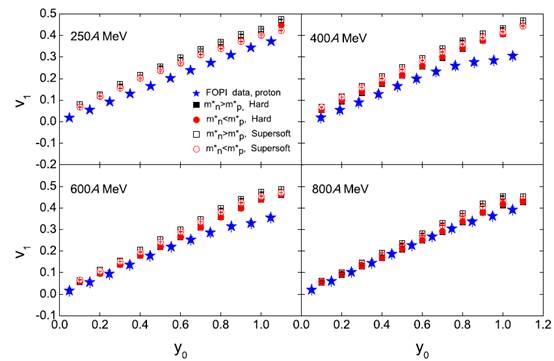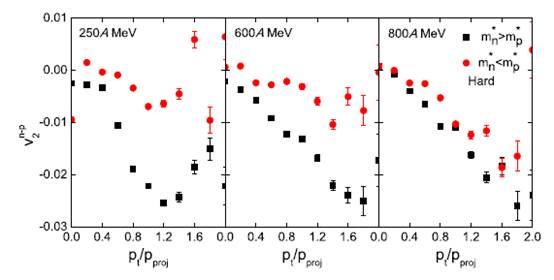Nuclear collective flows produced in semicentral heavy ion collisions at intermediate energies and their dependence on the momentum-dependent symmetry potential has been investigated within the isospin-dependent quantum molecular dynamics (IQMD) transport model by theory physics group at Institute of Modern Physics (IMP), CAS. Important progress has been obtained in this work.
It is known that the nuclear collective flows, such as the directed and elliptic flows, are the useful tool for studying the equation of state of symmetry and asymmetry nuclear matter. Generally speaking, due to the interactions among nucleons, a nucleon deviates from its free mass in the medium. There will be the neutron-proton effective mass splitting if the isospin effects are considered. In the nonrelativistic framework, momentum-dependent symmetry potential is closely related to the neutron-proton effective mass splitting. The positive or negative signs of neutron-proton effective mass splitting correspond to completely different momentum-dependent symmetry potential. The researchers have to constrain the nucleon mass splitting before constraining the momentum-dependent symmetry potential.
Based on the IQMD model, in which the isospin effects in the momentum dependent interactions are incorporated, the directed and elliptic flows of protons and light cluster with mass number of A=3 produced in semicentral Au-Au collisions in the energy range from 250 to 800A MeV are calculated. It is found that theoretical calculations can reproduce the experimental data of the FOPI Collaboration. Neutron-proton differential flow and the difference of neutron-proton directed and elliptic flows are sensitive to the momentum-dependent symmetry potential, especially at larger momenta and rapidities. Moreover, this sensitivity is independent on both the isoscalar part of nuclear equation of state and in-medium cross sections. Thus Neutron-proton differential flow and the difference of neutron-proton directed and elliptic flows is the effective tool to extract the information of the momentum-dependent symmetry potential and neutron-proton effective mass splitting.
The results have been published in Physical Review C 91, 054609 (2015). This work was supported by the Major State Basic Research Development Program in China (Nos 2014CB845405 and 2015CB856903), the National Natural Science Foundation of China Projects (Nos 11175218 and U1332207).
The article can be linked as follows: http://link.aps.org/doi/10.1103/PhysRevC.91.054609 .

Fig. 1 Rapidity distributions of directed flow of protons produced in semicentral Au-Au collisions at 250, 400, 600 and 800A MeV.(Image by IMP)

Fig. 2 Transverse momentum distributions of the difference of neutron-proton elliptic flow in semicentral Au-Au collisions at 250, 600 and 800A MeV.(Image by IMP)

